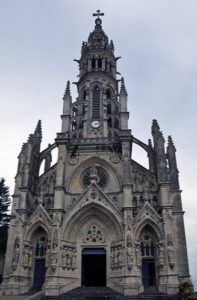Châteauneuf-sur-Cher is quite a big settlement with the shopping area below the château. This is a typical rectangular 16thC building with corner towers with pointed roofs. It is surrounded by a huge stone wall with a round tower at the corner.
We hadn’t intended to stop here, but our attention had been caught by the splendid church tower at the top of the town.
Basilique Notre-Dame des Enfants is built on top of the hill and is an amazing structure of flying buttresses, pinnacles, spires, carving, statues, gargoyles… It was built between 1870-1880 in grand Gothic style to replace the ruined 16thC church. Father Ducros, the newly appointed Dean of Châteauneuf , wrote to all the parishes asking the children for donations towards the building. The story goes that one little girl wrote asking that the new church be named Notre-Dame-des-Enfants and it is the only church in France to be called this.
It is built from the local very pale tufa stone. The nave is very tall with lower roofs on the chancel and ambulatory. Entry is up steps to the west door which has statues everywhere, bishops, saints, martyrs… Above the doorway is a carving of the Virgin with two small children and the initials ND DE carved above.
The inside of the church is huge. It was a pity about the coloured streamers draped from the ceiling across to the walls which obscured the building.
There are tall elegant fluted pillars with pointed arches and a small carved frieze at the top of the pillars. Above is arcading with round pillars, round arches and windows above. The ceiling is vaulted with roof bosses.
At the back of the south aisle is a stone font. Three pillars support a very ornate carved spire with pinnacles above the font. The stained glass window shows John the Baptist baptising Christ.
Under the windows in the aisles are massive carved Stations of the Cross in elaborate frames, each explaining where they are. . The rest of the walls are covered with small ‘Merci’ plates. The huge carved wood pulpit has two flights of stairs up to it. On the front is a carved panel of Jesus preaching surrounded by panels of the four evangelists. Above is a massive carved spire with angels, flying buttresses and pinnacles.
There is a large organ in the choir. The wooden choir stalls are fairly plain with misericords. The chancel has a crucifix on the walls and a painted statue of the Virgin surrounded by children.
There is a simple wood mass alter with a highly carved stone high altar behind it which has a scene of the last supper on the base. Above are carvings of the apostles with angels and more spires. There are steps at the back, presumably to reach the candlesticks.
The south chancel chapel has a carved stone altar with pillars and crosses on the base. There is a carved shelf on either side of the host box which has a gilt and pale blue enamel door and carved top with a cross. Above is an elaborately carved stone retable with more pinnacles. In the centre is Jesus with two smaller statues on either side. There is a statue of St Theresa on the chancel pillar.
The ambulatory is separated from the choir by pillars and pointed arches. It has three apses each with an altar. The south apse has a fairly simple altar with St Ann and the young Mary.
The central apse has a very ornate altar with carved figures on the base of adults bringing children to the Virgin. The retable has angels, spires and Biblical scenes including the raising of Jarus’s daughter from the dead. Above the retable is a huge statue of the Virgin standing on a rock with young children lit up by light bulbs. The walls around the altar are covered with ‘Merci’ plates.
The altar in the north apse is again fairly plain with a statue of Joseph and the young Jesus.
The north chancel altar is carved stone with carvings of angels on the base and carved leaves around the top of the altar and along the shelf. There is a statue of Mary and Joseph on the host box. On the chancel pillar is a statue of St Bernadette and on the wall opposite the altar are St Antoine de Padoue and Jeanne Marie de MAILLE 1332-1414 who was recorded as performing 39 miracles in her lifetime and 13 after her death.
The small chapel at the back of the north aisle has a stone altar with a carving of the burial of Christ on the bottom and a small carved retable. On the walls on either side are memorial plates listing the names of the dead from World War One. The rest of the space is filled with ‘Merci’ plates and there is a statue of Joan of Arc on the wall.
The stained glass windows are very colourful with a series of Biblical scenes including the temptation of Eve and Noah building his arc.
The door to the crypt on the outside of the north wall was locked.
Across the road from the east end of the church is a large presbytery.
This really is a wedding cake confection but possibly too OTT for comfort.









